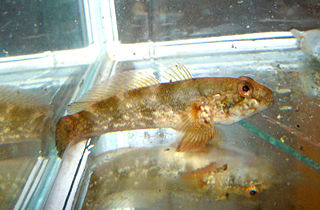
Gobiidae or gobies is a family of bony fish in the order Gobiiformes, one of the largest fish families comprising more than 2,000 species in more than 200 genera. Most of gobiid fish are relatively small, typically less than 10 cm (3.9 in) in length, and the family includes some of the smallest vertebrates in the world, such as Trimmatom nanus and Pandaka pygmaea, Trimmatom nanus are under 1 cm long when fully grown, then Pandaka pygmaea standard length are 9 mm (0.35 in), maximum known standard length are 11 mm (0.43 in). Some large gobies can reach over 30 cm (0.98 ft) in length, but that is exceptional. Generally, they are benthic or bottom-dwellers. Although few are important as food fish for humans, they are of great significance as prey species for other commercially important fish such as cod, haddock, sea bass and flatfish. Several gobiids are also of interest as aquarium fish, such as the dartfish of the genus Ptereleotris. Phylogenetic relationships of gobiids have been studied using molecular data.

Alburnoides is a genus of cyprinid fishes native to Europe and Asia. Many species are known as riffle minnows or spirlins.

Cobitis is a genus of small freshwater fish in the family Cobitidae from temperate and subtropical Eurasia. It contains the "typical spiny loaches", including the well-known spined loach of Europe. Similar spiny loaches, occurring generally south of the range of Cobitis, are nowadays separated in Sabanejewia.

Gobio is a genus of typical gudgeons, ray-finned fish in the family Cyprinidae many of which are endemics of south-eastern Europe. Members of the genus are usually small fish, rarely longer than 10 cm.

Knipowitschia is a genus of marine, fresh and brackish water gobies native to Eurasia. The genus name almost certainly honours Nikolai Mikhailovich Knipovich (1862-1938), a biologist who led a number of expeditions to the Caspian Sea.

Neogobius is a genus of gobies, native to Black Sea and the Caspian Sea basins. It is part of the broader Benthophilinae subfamily which is also endemic to the same region. Nevertheless, two Neogobius species have recently turned out to be highly invasive and spread across Europe and even to the Great Lakes of North America.

The racer goby is a species of goby native to fresh, sometimes brackish, waters, of the Black Sea basin. It is a Ponto-Caspian relict species. The species is placed a monotypic genus, Babka, which was once considered a subgenus of genus Neogobius, but was then elevated to genus-status based on the molecular analysis.

Ponticola kessleri, the bighead goby or Kessler's goby, is a species of goby native to Eurasia. The bighead goby is a Ponto-Caspian relict species. It inhabits the fresh and oligohaline waters, with mineralisation from 0-0.5‰ up to 1.5-3.0‰.

Proterorhinus marmoratus is a species of gobiid fish, a tubenose goby native to the brackish water parts of the Black Sea and the Sea of Azov, near the coasts of Bulgaria, Georgia, Romania, Ukraine and Russia. Also it is found in the Marmora Sea (Turkey). It can reach a length of 11.5 centimetres (4.5 in) TL.

Lake Sapanca is a fresh water lake in Turkey, between the Gulf of İzmit and the Adapazarı Meadow. The lake has a catchment area of 251 km2, surface area is 45 km2, a length 16 km east–west / 5 km north–south, and a maximum depth of 52 m. Lake Sapanca, Turkey

The tadpole-gobies (Benthophilus), also called pugolovkas, are a genus of Ponto-Caspian fish in the family Gobiidae.

Pinchuk's goby is a species of goby native to the Black Sea and the Sea of Azov.

The flatsnout goby is a species of goby endemic to the Black Sea where it is mostly known from inshore waters amongst rocks and boulders. It is occasionally found offshore over areas with gravel substrates. This species can reach a length of 22.5 centimetres (8.9 in) TL.

The ratan goby is a species of goby native to brackish and marine waters of the Black Sea, the Sea of Azov and the Caspian Sea. In the Caspian Sea it is presented by subspecies Ponticola ratan goebeli. It occurs in inshore waters, inhabiting areas with stone or gravel substrates. This species can reach a length of 20 centimetres (7.9 in) TL.

The Benthophilinae are a subfamily of gobies endemic to the Ponto-Caspian region. The subfamily includes about 50 species. The representatives of the subfamily have fused pelvic fins and elongated dorsal and anal fins. They are distinguished from the closely related subfamily Gobiinae by the absence of a swimbladder in adults and location of the uppermost rays of the pectoral fins within the fin membrane.
Neogobius pallasi, the Caspian sand goby or the Caspian monkey goby, is a species of fish native to fresh and brackish waters of the Caspian Sea basin including the Volga drainage up to the vicinity of Moscow. It has been introduced into the Aral basin. This species of goby can reach a length of 20 centimetres (7.9 in) SL. It is also important to local commercial fisheries.

Neogobius bathybius is a species of goby endemic to the Caspian Sea, where it occurs in depths down to 200 metres (660 ft). It is strictly confined to the brackish-water basin and does not enter fresh waters. It can grow up to a length of 25 centimetres (9.8 in) TL.

Benthophilus ragimovi is a deepwater species of gobiid fish found along the western coasts of the Caspian Sea, from the Chechen Island to Astara, Azerbaijan. It is one of the numerous species of benthophiline gobies endemic to the Ponto-Caspian region.

Capoeta razii, is a newly described species of freshwater cyprinid fish occurring mainly in the southern Caspian Sea basin, Iran. This species was mistakenly reported by many authors as Capoeta gracilis in northern Iranian regions. It was first reported to be different from C. gracilis by Levin et al. (2012).


















